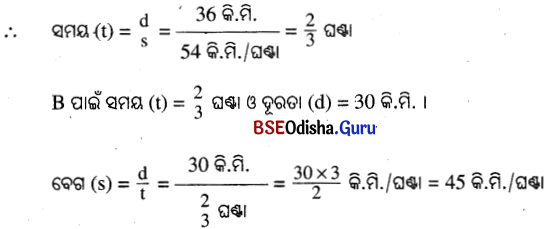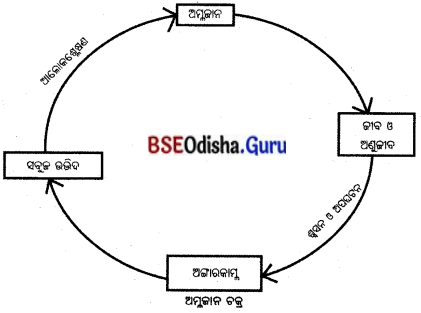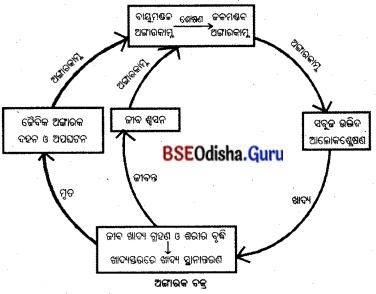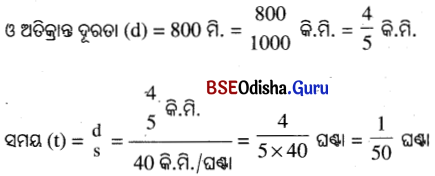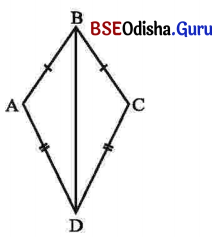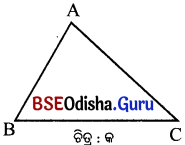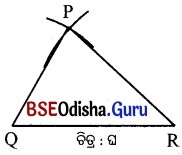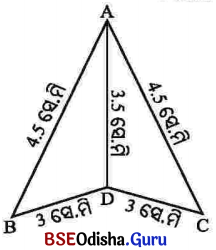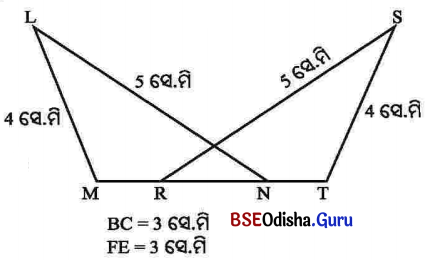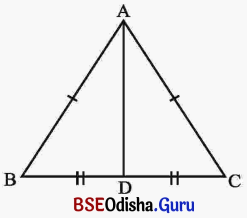Odisha State Board BSE Odisha 10th Class Odia Solutions Chapter 16 ବେଲ, ଅଶ୍ଵତ୍ଥ ଓ ବଟବୃକ୍ଷ Textbook Exercise Questions and Answers.
BSE Odisha Class 10 Odia Solutions Chapter 16 ବେଲ, ଅଶ୍ଵତ୍ଥ ଓ ବଟବୃକ୍ଷ
ପରୀକ୍ଷା ଉପଯୋଗୀ ଅତିରି
ନିର୍ଦ୍ଦିଷ୍ଟ ଉତ୍ତରମୂଳକ ପ୍ରଶ୍ନୋତ୍ତର
Question ୧। ଗଳ୍ପଟି କେଉଁ ପତ୍ରିକାରେ ପ୍ରକାଶ ପାଇଥିଲା ?
Answer:
ଗଳ୍ପଟି ନବରବି ପତ୍ରିକାରେ ପଞ୍ଚମ ବର୍ଷ ପତ୍ରିକାରେ ପ୍ରକାଶ ପାଇଥିଲା ।
Question
ନଟବର ବାବୁ ସରକାରୀ ବସ୍ରେ ଯାଇଥିଲେ କେତେବେଳେ ଗାଁ ପାଖରେ ପହଞ୍ଚି ଯାଇଥାନ୍ତେ ?
Answer:
ନଟବର ବାବୁ ସରକାରୀ ବସ୍ରେ ଯାଇଥିଲେ ସକାଳ ନଅଟା ବେଳକୁ ଗାଁ ପାଖରେ ପହଞ୍ଚି ଯାଇଥାନ୍ତେ ।
Question ୩ ।
ପଛ ବସ୍ ଧରି ଯାଇ କେଉଁଠି ଓହ୍ଲାଇ ପୁନର୍ବାର ଗାଁକୁ ଘରୋଇ କୁଜି ବସ୍ରେ ଗଲେ ?
Answer:
ଗଳ୍ପଟି ନବରବି ପତ୍ରିକାରେ ପଞ୍ଚମ ବର୍ଷ ପତ୍ରିକାରେ ପ୍ରକାଶ ପାଇଥିଲା ।
ପଛ ବସ୍ ଧରି ଯାଇ ଫୁଲ ନଖରାରେ ଓହ୍ଲାଇ ପୁନର୍ବାର ଗାଁକୁ ଘରୋଇ କୁଜି ବସ୍ରେ ଗଲେ ।
Question ୪।
ବୈଶାଖ ମାସରେ କେତେବେଳେ ବାହାରକୁ ଗୋଡ଼ କାଢ଼ି ହୁଏ ନାହିଁ ?
Answer:
ବୈଶାଖ ମାସରେ ସକାଳ ଆଠଟାବେଳେ ବାହାରକୁ ଗୋଡ଼ କାଢ଼ି ହୁଏ ନାହିଁ ।
Question ୫ ।
ଏଗାରଟା ବେଳକୁ ଚାରିଆଡ଼ କ’ଣ ଜଳିଲା ପରି ଜଣାଯାଉଛି ?
Answer:
ଏଗାରଟା ବେଳକୁ ଚାରିଆଡ଼ ନିଆଁ ଜଳିଲାପରି ଜଳିଲା ପରି ଜଣାଯାଉଛି ।
![]()
Question ୬ ।
ହରି ଗୁଡ଼ିଆ କେଉଁ ଗଛ ତଳେ ଦୋକାନ କରିଥିଲା ?
Answer:
ହରି ଗୁଡ଼ିଆ ଚାକୁଣ୍ଡା ଗଛ ତଳେ ଦୋକାନ କରିଥିଲା
Question ୭ ।
ବାଉଁଶ ପାଚିଆରେ କ’ଣ ଥିଲା ?
Answer:
ବାଉଁଶ ପାଚିଆରେ ସକାଳୁ ହୋଇଥିବା ବରା, ଗୁଲୁଗୁଲା, ପକୁଡ଼ି ଓ ବୁନ୍ଦିଆ ମିଠେଇ ଥିଲା ।
Question ୮ ।
ଖୋଲା ଡେକ୍ରେ କେତେ ଗୋଟି ରସଗୋଲା ଥିଲା ?
Answer:
ଖୋଲା ଡେକ୍ରେ ଚାରି ଛଅଟା ରସଗୋଲା ଥିଲା ।
Question ୯ ।
ହରି ଗୁଡ଼ିଆ କାହା ଉପରେ ଗଡ଼ପଡ଼ ହେଉଥିଲା ?
Answer:
ହରି ଗୁଡ଼ିଆ ଖଣ୍ଡିଏ ଛିଣ୍ଡା ସିପ ଉପରେ ଗଡ଼ପଡ଼ ହେଉଥିଲା ।
Question ୧୦ ।
ବାସନଧୁଆ ଟୋକାଟା କେଉଁଠି ଶୋଇଥିଲା ?
Answer:
ବାସନଧୁଆ ଟୋକାଟା ବେଞ୍ଚ ଉପରେ ଶୋଇଥିଲା ।
Question ୧୧ ।
ନଟବର ବାବୁ କାହାକୁ ପାଣି ପିଇବାକୁ ମାଗିଲେ ?
Answer:
ନଟବର ବାବୁ ବାସନ ଧୂଆ ଟୋକାକୁ ପାଣି ପିଇବାକୁ ମାଗିଲେ ।
Question ୧୨ ।
ନଟବର ବାବୁଙ୍କୁ କିଏ ମଣିଷ କରିଛି ?
Answer:
ନଟବର ବାବୁଙ୍କ ବୋଉ ନଟବର ବାବୁଙ୍କୁ ମଣିଷ କରିଛି ।
Question ୧୩ ।
କିଏ ଅକୃତଜ୍ଞ ବୋଲି ନଟବର ବାବୁ ଭାବିଛନ୍ତି ?
Answer:
ମଣିଷ ଜାତିଟା ଅକୃତଜ୍ଞ ବୋଲି ନଟବର ବାବୁ ଭାବିଛନ୍ତି ।
![]()
Question ୧୪ ।
ବଡ଼ ପୁଅ ବି.ଏ. ପଢ଼ୁ ପଢ଼ୁ କ’ଣ ହୋଇଗଲା ?
Answer:
ବଡ଼ ପୁଅ ବି.ଏ. ପଢ଼ୁ ପଢ଼ୁ ହିପି ହୋଇଗଲା ।
Question ୧୫ ।
‘ମୋତେ ଯେତେ ମାଠିବୁ ମାଠ’ କାହା ବିଷୟରେ କୁହାଯାଇଛି ? ..
Answer:
‘ମୋତେ ଯେତେ ମାଠିବୁ ମାଠ’ ସାନ ଝିଅ ବିଷୟରେ କୁହାଯାଇଛି ।
Question ୧୭ ।
ବେଲବଣ ମଝିରେ କେଉଁ ମନ୍ଦିର ଅଛି ?
Answer:
ବେଲବଣ ମଝିରେ ଶିବ ମନ୍ଦିର ଅଛି ।
Question ୧୮ ।
ବାଉଁଶ ବାଡ଼ି ଶେଷରେ କ’ଣ ଅଛି ?
Answer:
ବାଉଁଶ ବାଡ଼ି ଶେଷରେ ମନ୍ଦିର ଅଛି ।
Question ୧୯ ।
ମନ୍ଦିର ଆଗରେ କାହା ଘର ?
Answer:
ମନ୍ଦିର ଆଗରେ ମଧୁ ତିଆଡ଼ିର ଘର ।
Question ୨୦ ।
ମନ୍ଦିରର ପୂଜକ କିଏ ?
Answer:
ମନ୍ଦିରର ପୂଜକ ମଧୁ ତିଆଡ଼ି ।
Question ୨୧ ।
ବଉଳ ଗଛ ଛାଇରେ କିଏ ଭାଗବତ ପଢ଼ୁଥିଲେ ?
Answer:
ମଧୁ ତିଆଡ଼ିଏ ବଉଳ ଗଛ ଛାଇରେ ଭାଗବତ ପଢ଼ୁଥିଲେ ।
Question ୨୨ ।
ମଦନପୁର ଓ ତାଙ୍କ ମୌଜାର ସୀମା କେଉଁ ଗଛ ଚିହ୍ନଟ କରୁଛି ?
Answer:
ପ୍ରକାଣ୍ଡ ବରଗଛ ମଦନପୁର ଓ ତାଙ୍କ ମୌଜାର ସୀମା ଚିହ୍ନଟ କରୁଛି ।
Question ୨୩ ।
ବରଗଛ କୋରଡ଼ରେ କେଉଁ ଗଛ ଉଠିଥିଲା ?
Answer:
ବରଗଛ କୋରଡ଼ରେ ବେଲଗଛ ଓ ଅଶ୍ଵତ୍ଥ ଗଛ ଉଠିଥିଲା ।
Question ୨୪ ।
ବରଗଛର ପ୍ରତୀକ କିଏ ?
Answer:
ନଟବରବାବୁଙ୍କ ବୋଉ ବରଗଛର ପ୍ରତୀକ ।
Question ୨୫ ।
ନଟବର ବାବୁ କେଉଁ ଗଛର ପ୍ରତୀକ ?
Answer:
ନଟବର ବାବୁ ବେଲଗଛର ପ୍ରତାକା
![]()
ବିଗତ ବର୍ଷର ହାଇସ୍କୁଲ ପରୀକ୍ଷା (ବାର୍ଷିକ ଓ ସପ୍ଲିମେଣ୍ଟାରୀ)ର ପ୍ରଶ୍ନୋତ୍ତର
Question 1.
ହରି ଗୁଡ଼ିଆ କେଉଁ ଗଛ ତଳେ ଦୋକାନ କରିଥିଲା ?
Answer:
ଚାକୁଣ୍ଡ
Question 2.
ଗଳ୍ପରେ ସଂସାରକୁ କାହା ସହିତ ତୁଳନା କରାଯାଇଛି ?
Answer: ତତଲା ଲୁହା କରେଇ / କଡ଼େଇ
Question 3.
‘‘ମୋତେ ଯେତେ ମାଠିବୁ ମାଠ’’ – ଏ ଉକ୍ତିଟି କାହା ଉଦ୍ଦେଶ୍ୟରେ କୁହାଯାଇଛି ?
Answer:
ନଟବରବାବୁଙ୍କ ସାନଝିଅ
Question 3.
ହରି ଗୁଡ଼ିଆ କାହା ଉପରେ ଶୋଇ ଗଡ଼ପଡ଼ ହୋଉଥିଲା ?
Answer:
ଛିଣ୍ଡାସପ ଉପରେ,
![]()
Question 4.
‘‘ମୋତେ ଯେତେ ମାଠିବୁ ମାଠ’’ – ଏ ଉକ୍ତିଟି କାହା ଉଦ୍ଦେଶ୍ୟରେ କୁହାଯାଇଛି ?
Answer:
ନଟବରବାବୁଙ୍କ ସାନଝିଅ
Question 5.
ପଠିତ ଗଳ୍ପରେ ବଟବୃକ୍ଷକୁ କାହାର ପ୍ରତୀକ ଭାବରେ ଦର୍ଶାଯାଇଛି ?
Answer:
ଜନନ।ର
Question 6.
ଗଳ୍ପରେ ବର୍ଣ୍ଣିତ ମଧୁ ତିଆଡ଼ି କିଏ ?
Answer:
ମନ୍ଦିରର ପୂଜକ
Question 7.
ଅଶ୍ଵତ୍ଥ ଗଛ ଓ ବେଲଗଛ କେଉଁଠି ଉଠିଥିଲା ?
Answer:
ବଙ୍ଗଳରେ
Question 8.
‘ବେଲ, ଅଶ୍ଵତ୍ଥ ଓ ବଟବୃକ୍ଷ’ ଗଳ୍ପରେ କେଉଁ ଋତୁର ଘଟଣା ବର୍ଣ୍ଣନା କରାଯାଇଛି ?
Answer:
ଖ୍ରୀଷ୍ଟ
Question 9.
ମଣିଷ ଜାତିକୁ ନଟବରବାବୁ କ’ଣ ବୋଲି ଭାବିଛନ୍ତି ?
Answer:
Question 10.
ହଁ, ସଂସାରଟା ଆଉ କ’ଣ ? ତତଲା ଲୁହା କଡ଼େଇ ତ’ ଏମିତି କିଏ ଭାବିଛନ୍ତି ?
Answer:
ପରୀକ୍ଷା ଉପଯୋଗୀ ଅତିରିକ୍ତ ପ୍ରଶ୍ନୋତ୍ତର
(A) ।ଗୋଟିଏ ବାକ୍ୟରେ ଉତ୍ତର ଦିଅ ।
Question 1.
ଲେଖକ ରବି ପଟ୍ଟନାୟକ କେଉଁଠାରେ ଜନ୍ମଗ୍ରହଣ କରିଥିଲେ ?
Answer:
ଲେଖକ ରବି ପଟ୍ଟନାୟକ ମୟୂରଭଞ୍ଜ ଜିଲ୍ଲାର ରାଇରଙ୍ଗପୁରରେ ଜନ୍ମଗ୍ରହଣ କରିଥିଲେ ।
Question 2.
ତାଙ୍କ ରଚିତ କେଉଁ ପୁସ୍ତକ ଓଡ଼ିଶା ସାହିତ୍ୟ ଏକାଡ଼େମୀଦ୍ଵାରା ପୁରସ୍କୃତ ହୋଇଛି ?
Answer:
ତାଙ୍କ ରଚିତ ‘ହିରଣ୍ୟଗର୍ଭା’ ପୁସ୍ତକ ଓଡ଼ିଶା ସାହିତ୍ୟ ଏକାଡ଼େମୀଦ୍ଵାରା ପୁରସ୍କୃତ ହୋଇଛି ।
Question 3.
କେଉଁ ପୁସ୍ତକ ପାଇଁ ଲେଖକଙ୍କୁ ମରଣୋତ୍ତର ଶାରଳା ପୁରସ୍କାର ପ୍ରଦାନ କରାଯାଇଛି ?
Answer:
‘ବନ୍ଧ୍ୟା ଗାନ୍ଧାରୀ’ ପୁସ୍ତକ ପାଇଁ ଲେଖକଙ୍କୁ ମରଣୋତ୍ତର ଶାରଳା ପୁରସ୍କାର ପ୍ରଦାନ କରାଯାଇଛି ।
Question 4.
କାହାର ଜୀବନ ଧନ୍ୟ ବୋଲି କୁହାଯାଇଛି ?
Answer:
ବୃକ୍ଷର ଜୀବନ ଧନ୍ୟ ବୋଲି କୁହାଯାଇଛି ।
Question 5.
ହରିକୁ କିଏ ଧୀର ଗଳାରେ ଡାକିଲେ ?
Answer:
ନଟବରବାବୁ ହରିକୁ ଧୀର ଗଳାରେ ଡାକିଲେ ।
![]()
Question 6.
ନଟବରବାବୁ ବସ୍ଷ୍ଟାଣ୍ଡରେ ପହଞ୍ଚିଲାବେଳକୁ କ’ଣ ହେଲା ?
Answer:
ନଟବରବାବୁ ବସ୍ଷ୍ଟାଣ୍ଡରେ ପହଞ୍ଚିଲାବେଳକୁ ବସ୍ ଷ୍ଟେସନ୍ ଛାଡ଼ିଦେଲା ।
Question 7.
ବସ୍ରେ ଯାଇଥିଲେ କେତେବେଳେ ଗାଁରେ ପହଞ୍ଚା’ନ୍ତେ ?
Answer:
ବସ୍ରେ ଯାଇଥିଲେ ନଅଟାବେଳେ ଗାଁରେ ପହଞ୍ଚି’ନ୍ତେ ।
Question 8.
ଦିନ ୧୧ଟା ବେଳକୁ କିପରି ଲାଗୁଥିଲା ?
Answer:
ଦିନ ୧୧ଟା ବେଳକୁ ନିଆଁ ଜଳିଲା ପରି ଲାଗୁଥିଲା ।
Question 9.
ହରି ଗୁଡ଼ିଆର ଦୋକାନଟି କିପରି ଥିଲା ?
Answer:
ହରି ଗୁଡ଼ିଆର ଦୋକାନ ଝାଟିମାଟି କାନ୍ଥ ଓ ତାଳ ବରଡ଼ାର ଛପର ଘରଥିଲା ।
Question 10.
କ’ଣ ପିନ୍ଧି ହରି ଗୁଡ଼ିଆ ଗୋଟିଏ କଣରେ ଗଡ଼ପଡ଼ ହେଉଥୁଲା ?
ଢ-
ନାଲି କରିଆ ଖଣ୍ଡେ ପିନ୍ଧି ହରି ଗୁଡ଼ିଆ ଗଡ଼ପଡ଼ ହେଉଥିଲା ।
Question 11.
ନଟବରବାବୁ କାହା ବିଷୟରେ ତାର ପାଇଲେ ?
Answer:
ନଟବାବୁ ବୋଉ ଦେହ ଖରାପ ଥିବାର ତାର ପାଇଲେ ।
Question 12.
ଖରା ତେଜରେ କ’ଣ ବୁଜି ଆସୁଛି ?
Answer:
ଖରା ତେଜରେ ଆଖୁଦିଟା ବୁଜି ଆସୁଛି ।
Question 13.
ମଣିଷ ଜାତିଟା କିପରି ?
Answer:
ମଣିଷ ଜାତିଟା ଅକୃତଜ୍ଞ କୃତଘ୍ନ ।
Question 14.
ନଟବରବାବୁଙ୍କ ବଡ଼ପୁଅଟା କ’ଣ ହୋଇଗଲା ?
Answer:
ନଟବରବାବୁଙ୍କ ବଡ଼ପୁଅଟା ବି.ଏ. ପଢ଼ୁ ପଢ଼ୁ ହିପି ହୋଇଗଲା ।
Question 15.
ପଞ୍ଜାବୀଟା କାହିଁକି ଓଦା ହୋଇ ଯାଇଥିଲା ?
Answer:
ଝାଳରେ ପଞ୍ଜାବୀଟା ଓଦା ହୋଇ ଯାଇଥିଲା ।
Question 16.
ତାଳଗଛ କିପରି ଛିଡ଼ା ହୋଇ ରହିଛନ୍ତି ?
Answer:
ତାଳଗଛଗୁଡ଼ା ବାବନାଭୂତ ପରି ଛିଡ଼ା ହୋଇ ରହିଛନ୍ତି ।
![]()
Question 17.
ବେଲବଣ କେଉଁଠି ?
Answer:
ପୋଖରୀର ଗୋଟିଏ କୋଣକୁ ବେଲବଣ ।
Question 18.
ପୁରାଦିନ ଶିବ ମନ୍ଦିର କେଉଁଠି ?
Answer:
ବେଲବଣ ମଝିରେ ପୁରାତନ ଶିବ ମନ୍ଦିର ।
Question 19.
ବେଲବଣ ଭିତରେ କିଏ କଣ୍ଟା ଆଡ଼େଇ ପଶିଲେ ?
Answer:
ନଟବଉବାବୁ ବେଲବଣ ଭିତରେ କଣ୍ଟା ଆଡ଼େଇ ପଶିଲେ ।
Question 20.
ଗାଁ ମୁଣ୍ଡରେ କାହାର ବାଉଁଶ ବାଡ଼ି ?
Answer:
ଗାଁ ମୁଣ୍ଡରେ ବନ୍ଧୁ ଷଡ଼ଙ୍ଗୀର ବାଉଁଶ ବାଡ଼ି ।
Question 21.
ମନ୍ଦିର ଆଗରେ କାହାର ଘର ?
Answer:
ମନ୍ଦିର ଆଗରେ ମଧୁ ତିଆଡ଼ୀର ଘର ।
Question 22.
ମଧୁ ତିଆଡ଼ୀ ନଟବରକୁ କ’ଣ କହିଲେ ?
Answer:
ମଧୁ ତିଆଡ଼ୀ ନଟବରକୁ କହିଲେ ‘ଏ ଧୂମ୍ ଖରାବେଳେ କୁଆଡ଼େ ବାହାରିଛୁ ।
Question 23.
ନଡ଼ିଆ ବଣ ଭିତରେ କ’ଣ ଚକ୍ରମକ୍ ହୋଇ ଦିଶୁଥିଲା ?
Answer:
ନଡ଼ିଆ ବଣ ଭିତରେ ସୁରଜର୍ମଲର ଧଳାକୋଠା ଚକ୍ରମକ୍ ହୋଇ ଦିଶୁଥିଲା ।
Question 24.
ମଦନପୁର ମୌଜା ଓ ନଟବରଙ୍କ ମୌଜାର ସୀମାକୁ କିଏ ଚିହ୍ନଟ କରୁଥିଲା ?
Answer:
ମଦନପୁର ମୌଜା ଓ ନଟବରଙ୍କ ମୌଜାର ସୀମାକୁ ଏକ ପ୍ରକାଣ୍ଡ ବରଗଛ ଚିହ୍ନଟ କରୁଥିଲା ।
Question 25.
କେଉଁ ଗଛମୂଳେ ବସି ବୁଦ୍ଧଦେବ ବୁଦ୍ଧତ୍ୱ ପ୍ରାପ୍ତ ହୋଇଥିଲେ ?
Answer:
ଅଶ୍ଵତ୍ଥ ଗଛମୂଳେ ବସି ବୁଦ୍ଧଦେବ ବୁଦ୍ଧତ୍ୱ ପ୍ରାପ୍ତ ହୋଇଥିଲେ ।
Question 26.
ଦୁଇଚାରିଟା ପିଲା ଗଛ ଓହଳରେ କ’ଣ ଖେଳୁଥିଲେ ?
Answer:
ଦୁଇଚାରିଟା ପିଲା ଗଛ ଓହଳରେ ଡାଳମାଙ୍କୁଡ଼ି ଖେଳୁଥିଲେ ।
![]()
Question 27.
ନଟବର ଗଛମୂଳେ କ’ଣ କଲେ ?
Answer:
ନଟବର ମୁଣ୍ଡତଳେ ଗାମୁଛା ଦେଇ ଗଛମୂଳରେ ଗଡ଼ି ପଡ଼ିଲେ
Question 28.
ନଟବରଙ୍କ କେଉଁଠାରେ ଫୋଟକା ବାହାରିଥିଲା ?
Answer:
ନଟବରଙ୍କ କାଣି ଆଙ୍ଗୁଳି କଣରେ ଫୋଟକା ବାହାରିଥିଲା
Question 29.
କାହାର ଶବ୍ଦରେ କାନ ଅତଡ଼ା ପଡ଼ୁଥିଲା ?
Question 30.
କେଉଁମାନେ ଚାରିକାତ ମେଲେଇ ନିଦରେ ଶୋଇ ଯାଇଥିଲେ ?
Answer:
କେତେ ଜଣ ବାଟୋଇ ଚାରିକାତ ମେଲେଇ ନିଦରେ ଶୋଇ ଯାଇଥିଲେ ।
(B) ଗୋଟିଏ ପଦ ବା ଶବ୍ଦରେ ଉତ୍ତର ଦିଅ ।
Question 1.
‘ବେଲ, ଅଶ୍ଵତ୍ଥ ଓ ବଟବୃକ୍ଷ’ ଗଳ୍ପରେ କାହାର ମହାନତା ପ୍ରସଙ୍ଗ ହୃଦୟସ୍ପର୍ଶୀ ହୋଇଛି ?
Answer:
ବାତ୍ସଲ୍ୟ ଓ ମାତୃତ୍ଵର,
Question 2.
ଗଳ୍ପରେ କାହାକୁ ଜନନୀର ପ୍ରତୀକ ଭାବେ ବର୍ଣ୍ଣନା କରାଯାଇଛି ?
Answer:
ବଟବୃକ୍ଷକୁ
Question 3.
ନଟବରବାବୁ ସରକାରୀ ବସ୍ରେ ଯାଇଥିଲେ କେତେଟାରେ ଗାଁ ପାଖରେ ପହଞ୍ଚି’ନ୍ତେ ?
Answer:
ନଅଟାରେ
Question 4.
ନଟବରବାକୁ ଘରୁ ବସ୍ରେ ଯାଇ କେଉଁଠାରେ ଓହ୍ଲାଇଥିଲେ ?
Answer:
ଫୁଲନଖରାରେ
Question 5.
ହରି ଗୁଡ଼ିଆର ଜଳଖୁଆ ଦୋକାନଟି କେଉଁ ଗଛତଳେ ଥିଲା ?
Answer:
ଚାକୁଣ୍ଡା ଗଛ
Question 6.
ହରି ଗୁଡ଼ିଆର ଚାଳିଆ କେଉଁଥିରେ ଛପର ହୋଇଥିଲା ?
Answer:
ତାଳବରଡ଼ାରେ
![]()
Question 7.
ହରି ଗୁଡ଼ିଆର ଚାଳିଆର କାନ୍ଥ କେଉଁଥରେ ତିଆରି ହୋଇଥିଲା ?
Answer:
ଝାଟିମାଟିରେ
Question 8.
ହରି ଗୁଡ଼ିଆର ପାଟି ଶୁଣି କିଏ ଛିଡ଼ା ହୋଇଯାଇଥିଲା ?
Answer:
ବାସନମଜା ଟୋକା
Question 9.
ନଟବରବାବୁଙ୍କ ଶିଶୁ ମନରେ କେଉଁ ଭାବନା ଥିଲା ?
Answer:
ବୋଉକୁ ସୁଖରେ ରଖୁବାର
Question 10.
ୟୋତ୍ସର୍ଗ ସତ୍ତ୍ଵେ ନଟବରବାବୁ ପିଲାଙ୍କ ମନରେ କ’ଣ ଦେଖୁପାରି ନାହାଁନ୍ତି ?
Answer:
ମଣିଷ ହେବାର ଆକାଂକ୍ଷା
Question 11.
ନଟବରବାବୁଙ୍କ ବଡ଼ପୁଅ କେଉଁ ସମୟରେ ଘରକୁ ଆସେ ?
Answer:
ଖାଇବା ଓ ଶୋଇବା ସମୟରେ
Question 12.
ନଟବରବାବୁଙ୍କ କେଉଁ ଝିଅ ନାଁରେ ପରୋକ୍ଷଭାବେ କେତେ କଥା ଶୁଣାଗଲାଣି ?
Answer:
ସାନଝିଅ ନାଁରେ
Question 13.
ପିଲାମାନେ କ’ଣ ହେଲେ ଜୀବନରୁ ସୁଖ ଶେଷ ହୋଇଯାଏ ?
Answer:
ଅମଣିଷ
Question 14.
ହରିଚନ୍ଦନପୁର କେଉଁ ଶାସନ ?
Answer:
ବ୍ରାହ୍ମଣ
Question 15.
ପାନ, ଜଳଖୁ ଦୋକାନର ଚାଳିଆଟି କାହାର ?
Answer:
ହରି ଗୁଡ଼ିଆ
Question 16.
‘ ଆରେ ନଟ କିରେ, ଏଇ ଧୂମ ଖରାବେଳଟାରେ କୁଆଡ଼ିକି ବାହାରିଛି ?’’ ଏ ସ୍ନେହପୂର୍ଣ୍ଣ ଉକ୍ତିଟି କାହାର ଥିଲା ?
Answer:
ମଧୁ ତିଆଡ଼ି
Question 17.
ନଟବରବାବୁ ଗାଁକୁ ଯିବା ସମୟରେ କ’ଣ ପିନ୍ଧି ଯାଇଥିଲେ ?
Answer:
Question 18.
ମଦନପୁର ଓ ନଟବାବୁଙ୍କ ଗାଁ ମଝିରେ କେଉଁ ଗଛ ସୀମା, ନିର୍ଦ୍ଦେଶ କରୁଛି ?
Answer:
ବରଗଛ
Question 19.
‘ବେଲ, ଅଶ୍ଵତ୍ଥ ଓ ବଟବୃକ୍ଷ’ – କାହାର କୃତି ?
Answer:
ରବି ପଟ୍ଟନାୟକ
![]()
Question 20.
ସିଲ୍ଭର ଚଟୁ ଉପରେ ଚିନି ସିରା ଲାଗି ଶୁଖ୍ ଯାଇଥବା ଜାଗାଟିରେ କେଉଁମାନେ ରାଜତ୍ଵ କରୁଥିବାର ନଟବରବାବୁ ଦେଖିଲେ ?
Answer:
ମାଛିମାନେ
Question 21.
ଗାଁ ଗୁଡ଼ିଆ ଦୋକାନମାନଙ୍କରେ ବରା, ଗୁଲୁଗୁଲା ଓ ପକୁଡ଼ି ପ୍ରଭୃତି କେଉଁଥିରେ ସଜା ହୋଇ ରଖାଯାଇଥାଏ ?
Answer:
ବାଉଁଶ ପାଛିଆରେ
Question 22.
ବାସନଧୁଆ ଟୋକାଟା କେଉଁଠାରେ ଶୋଇଥିଲା ?
Answer:
ବେଞ୍ଚରେ
Question 23.
ହରି ଗୁଡ଼ିଆ କେଉଁଠାରେ ଶୋଇଥିଲା ?
Answer:
ଛିଣ୍ଡା ସପରେ
Question 24.
ହରି ଗୁଡ଼ିଆ ପାଇଁ କାହା ଗଳାର ସ୍ଵର ପରିଚିତ ଥିଲା ?
Answer:
ନଟବରବାବୁ
Question 25.
‘ଛି ଛି ଛି – ଏ କାଳ କଥା ଆଉ ତୁଣ୍ଡରେ ଧର ନାହିଁ’ – ଏକଥା କିଏ କହିଥିଲେ ?
Answer:
ହରି ଗୁଡ଼ିଆ
Question 26.
ଗ୍ରାମମାନଙ୍କୁ ବର୍ଷାଦିନେ କେଉଁ ରାସ୍ତାରେ ପାଦରେ ଚାଲି ଚାଲି ଯାଉଥିଲେ ?
Answer:
ହିଡ଼ ରାସ୍ତାରେ
Question 27.
କିଏ ନଟବରବାବୁଙ୍କୁ କେବେହେଲେ କିଛି ମାଗି ନାହିଁ, କେବଳ ଦେଇ ଚାଲିଛି ?
Answer:
ତାଙ୍କ ବୋଉ
Question 28.
ଗଛ ନୂତନ ସୃଷ୍ଟି ନିମନ୍ତେ କାହାକୁ ସବୁବେଳେ ନିଜର ଭାବେ ରଖିବାକୁ ଚାହେଁ ନାହିଁ ?
Answer:
ପୁରୁଣା ପତ୍ରକୁ
Question 29.
ଗାଁ ମୁଣ୍ଡ ପୋଖରୀ ହୁଡ଼ାରେ କେଉଁ ଗଛଗୁଡ଼ିକ ବାବନାଭୂତ ପରି ଛିଡ଼ା ହୋଇଛନ୍ତି ବୋଲି ଗାଳ୍ପିକ କହିଛନ୍ତି ?
Answer:
ତାଳଗଛ
![]()
Question 30.
ଗାଁର ବେଲବଣ ମଝିରେ କେଉଁ ମନ୍ଦିର ରହିଛି ?
Answer:
ଶିବ ମନ୍ଦିର
Question 31.
ଗାଁ ମୁଣ୍ଡରେ କାହାର ବାଉଁଶ ବାଡ଼ି ଅଛି ?
Answer:
ବନ୍ଧୁ ଷଡ଼ଙ୍ଗୀର
Question 32.
ନଡ଼ିଆ ବଣ ଭିତରେ କାହାର ଧଳାକୋଠା ଚକ୍ରମକ୍ କରୁଥିଲା ?
Answer:
ସୁରଜମଲ ମାରୁଆଡ଼ିର
Question 33.
ଅଶ୍ଵତ୍ଥ ଗଛମୂଳେ ବସି କିଏ ପରମ ଜ୍ଞାନ ଲାଭ କରିଥିଲେ ?
Answer:
ମହାବୀର
Question 34.
‘କି ଅଛି ଏଇ ଗଛରେ ? ନା ଟିକିଏ ଛାଇ – ନା ତା’ର କାଠ କିଛି କାମରେ ଆସୁଛି ?’’ ନା ତା’ର କାଠ କିଛି କାମରେ ଆସୁଛି ?’’ – ଏକଥା ନଟବର କେଉଁ ଗଛକୁ ଲକ୍ଷ୍ୟ କରି କହିଛନ୍ତି ?
Answer:
ଅଶ୍ଵତ୍ଥ ଗଛ
Question 35.
କେଉଁ ଗଛ ବିରାଟ ହେଲେ ମଧ୍ୟ ତା’ର ଫଳ ଅତ୍ୟନ୍ତ ଛୋଟ ?
Answer:
ଅଶ୍ଵତ୍ଥ
Question 36.
କେଉଁ ଗଛ ଗଣ୍ଡି ଉପରେ ମୋଟା ନାଲି ସିନ୍ଦୂର ଦାଗ ନଟବର ଦେଖିଲେ ?
Answer:
ଅଶ୍ୱତ୍ଥ
Question 37.
ଗଛର ନାଲି ସିନ୍ଦୂର ଦାଗ ତଳକୁ କେଉଁ ଧାର ଲମ୍ବିଥିଲା ?
Answer:
ପିମ୍ପୁଡ଼ିର ଧାର
Question 38.
ଗଛ ତଳକୁ ପିମ୍ପୁଡ଼ିର ଧାର କାହିଁକି ଲମ୍ବିଥିଲା ?
Answer:
ସୁରଜମଲ ଗୁଡ଼ କି ଚିନି ଦେଇଥିବାରୁ କି
Question 39.
ବୁଦ୍ଧଦେବ କେଉଁ ଗଛମୂଳେ ବୁଦ୍ଧତ୍ବ ପ୍ରାପ୍ତ ହୋଇଥିଲେ ?
Answer:
ଅଶ୍ଵତ୍ଥ ବୃକ୍ଷ
(C) ଶୂନ୍ୟସ୍ଥାନ ପୂରଣ କର ।
1. ବାସନଧୁଆ ଟୋକାଟା …………………… ରେ ଶୋଇଥିଲା ।
Answer:
ବେଞ୍ଚ
2. ହରି ଗୁଡ଼ିଆ …………………… ରେ ଶୋଇଥିଲା ।
Answer:
ଛିଣ୍ଡା ସପ
3. ଛି ଛି ଛି – ଏ କାଳ କଥା ଆଉ ତୁଣ୍ଡରେ ଧର ନାହିଁ – ଏକଥା ……………………….. କହିଥିଲେ ।
Answer:
ହରି ଗୁଡ଼ିଆ
4. ଗ୍ର।ମମାନଙ୍କରେ ବର୍ଷାଦିନେ ପାଦଚଲା ରାସ୍ତ୍ରୀ ………………………….. ଉପରେ ହୋଇଥାଏ ।
Answer:
ହିଡ଼
![]()
5. ଗାଁ ମୁଣ୍ଡ ପୋଖରୀ ହୁଡ଼ାରେ ……………………. ମାନେ ବାବନାଭୂତ ପରି ଛିଡ଼ା ହୋଇଛନ୍ତି ବୋଲି ଗାଳ୍ପିକ କହିଛନ୍ତି ।
Answer:
ତାଳଗଛ
6. ଗାଁର ବେଲବଶ ମଝିରେ …………………….. ମନ୍ଦିର ରହିଛି ।
Answer:
ଶିବ
7. ନତିଆ ବଶ ଭିତରେ ………………….. ର ଧଳାକେ।ଠା ଚକ୍ ମକ୍ କରୁଥିଲା
Answer:
ସୁରଜମଲ ମାରୁଆଡ଼ି
8. ଅଶ୍ୱତ୍ଥ ଗଛମୂଳେ ବସି ……………… ପରମ ଜ୍ଞାନ ଲାଭ କରିଥିଲୋ
Answer:
ମହାବୀର
9. ବସ୍ ଷ୍ଟାଣ୍ଡରୁ ଓହ୍ଲାଇ ନଟବରବାବୁ …………………… ଦୋକାନକୁ କ୍ଷାଇଥ୍ ଲୋ
Answer:
ହରି ଗୁଡ଼ିଆ,
10. ଗାଳ୍ପିକ ସଂସାରକୁ ……………………. ସହିତ ତୁଳନା କରିଛନ୍ତି ।
Answer:
ତତଲା ଲୁହା କରେଇ
11. ମନ୍ଦିର ଚଉତରା ଉପରେ ବସି ଲୋକମାନେ ………………… ଖେଳନ୍ତି ।
Answer:
ପ୍ରଶା
12. ବଉଳଗଛ ଛାଇରେ ବସି ମଧୁ ତିଆଡ଼ି ……………………. ପଢୁଥିଲେ ।
Answer:
ଭାଗବତ
13. ବୈଶାଖର ଗୈରିକ ଆକାଶ ଶ୍ୟାମଳ ମେଘର ବାତ୍ସଲ୍ୟମୟୀ କରୁଣାର …………………… ପୂରି ଉଠେ ।
Answer:
ବର୍ଷାରେ
14. ଅଶ୍ଵତ୍ଥ ଗଛ ବିରାଟ ବଡ଼ ହେଲେ ମଧ୍ୟ ତା’ର ଫଳ ଅତ୍ୟନ୍ତ ……………………..।
Answer:
ଛୋଟ
![]()
15. ବୁଦ୍ଧଦେବ ……………………. ଗଛମୂଳେ ବୁଦ୍ଧତ୍ୱ ପ୍ରାପ୍ତ ହୋଇଥିଲେ ।
Answer:
ଅଶ୍ୱତ୍ଥ
16. ଘରୁ ବସ୍ରେ ଯାଇ ନଟବରବାକୁ ……………………. ଠାରେ ଓହ୍ଲାଇଥିଲେ ।
Answer:
ଫୁଲନଖରା
17. ବୋଉର ତ୍ୟାଗ ଓ ଆୟୋତ୍ସର୍ଗ ସହିତ ତାଙ୍କର ମଧ୍ୟ ……………………….. ଥିଲା ।
Answer:
ପ୍ରଗାଢ଼ ଚେଷ୍ଟା
18. ପିଲାମାନେ ଅମଣିଷ ହେଲେ ଜୀବନରୁ …………………….. ଶେଷ ହୋଇଯାଏ ।
Answer:
ସୁଖ
19. ପୋଖରୀର କାଦୁଅଗୁଡ଼ା ଶୁଝାଇ ……………………… କୋଶିଆ ହୋଇ ଫାଟିଯାଇଛି।
Answer:
ହରି ଗୁଡ଼ିଆ
20. ପୋଖରୀର ଗୋଟିଏ କଣକୁ ………………………….. ଅଛି ।
Answer:
ବେଲବଣ
21. ନଟବରବାବୁ …………………… ବର୍ଷରେ ବାପଛେଉଣ୍ଡ ହୋଇଥିଲେ ।
Answer:
ପାଞ୍ଚ
22. ଖୋଲା ମୁହଁ ଡେକ୍ଟିରେ ………………………… ଟି ରସଗୋଲା ଥିଲା ।
Answer:
ଚାରି ଛଅଟି
23. ନଟବରବାବୁଙ୍କର ………………………. ଟି ଝିଅ ଥିଲା ।
Answer:
ଦୁଇ
24. ମନ୍ଦିରର ପୂଜକ ……………………. ଥିଲେ ।
Answer:
ମଧୁ ତିଆଡ଼ି
![]()
25. ଜୈନଧର୍ମର ପ୍ରବର୍ତ୍ତକ ………………………… ଥିଲେ ।
Answer:
ମହାବୀର
26. ବୌଦ୍ଧଧର୍ମର ଆଦି ପ୍ରବକ୍ତା ………………………।
Answer:
ଗୌତମ
(D) ଠିକ୍ ଉକ୍ତି ପାଇଁ ‘T’ଓ ଭୁଲ ଉକ୍ତି ପାଇଁ ‘F’ ଲେଖ ।
1. ଗୌତମ ଜୈନଧର୍ମର ପ୍ରବର୍ତ୍ତକ ଥିଲେ ।
2. ମହାବୀର ବୌଦ୍ଧଧର୍ମର ଆଦିପ୍ରବକ୍ତା ।
3. ବରଗଛ ତଳେ ଗୋରୁମାନେ ପାକୁଳି କରୁଥିବାର ନଟବର ଦେଖିଲେ ।
4. ବରଗଛକୁ ଗାଳ୍ପିକ ସ୍ନେହମୟୀ ଜନନୀ ସହିତ ତୁଳନା କରିଛନ୍ତି ।
5. ବରଗଛର କୋରଡ଼ ମଧ୍ୟରେ ବେଲ ଓ ଅଶ୍ଵତ୍ଥ ଗଛ ଉଠିଥିଲା ।
6. ‘ବେଲ, ଅଶ୍ଵତ୍ଥ ଓ ବଟବୃକ୍ଷ’ – ରବି ପଟ୍ଟନାୟକଙ୍କର କୃତି ।
7. ଗାଁ ମଝିରେ ବନ୍ଧୁ ଷଡ଼ଙ୍ଗୀର ବାଉଁଶ ବାଡ଼ି ।
8. ନଡ଼ିଆ ଗଛଟି ଛେଳି, ଗୋରୁ, ମାଙ୍କଡ଼, ଚଢ଼େଇ, ମଣିଷ ସମସ୍ତଙ୍କୁ ଆଶ୍ରୟ ଦେଇଛି ।
9. ଖରାଦିନେ ବେଲଗଛର ଡାଳଗୁଡ଼ିକ କଙ୍କାଳର ହାଡ଼ ପରି ଧଳା ଦେଖାଯାଏ ।
10. ମନ୍ଦିରର ପୂଜକ ମଧୁ ତିଆଡ଼ି ଥିଲେ ।
11. ବୈଶାଖ ମାସର ଦିନ ଏଗାରଟାବେଳକୁ ଚାରିଆଡ଼େ ନିଆଁ ଜଳିଲା ପରି ଜଣାପଡ଼େ ।
12. ଅଶ୍ଵତ୍ଥ ଗଛ ଗଣ୍ଡି ଉପରେ ମୋଟା ନାଲି ସିନ୍ଦୂର ଦାଗ ନଟବର ଦେଖିଥିଲେ ।
13. ଗଛର ନାଲି ସିନ୍ଦୂର ଦାଗ ତଳକୁ ପିମ୍ପୁଡ଼ିର ଧାର ଲମ୍ବିଥିଲା ।
14. ଭଗୀରଥ ସିନ୍ଧୁର ବାଟ କଢ଼େଇ ପୃଥିବୀକୁ ଆଣିଥିଲେ ।
15. ନଟବର ଆମ୍ବଗଛ ତଳେ ସାରା ଦେହରେ ମଧୁର ଶୀତଳ ସ୍ପର୍ଶ ଅନୁଭବ କରିଥିଲେ ।
Answer:
1. ଗୌତମ ଜୈନଧର୍ମର ପ୍ରବର୍ତ୍ତକ ଥିଲେ । (F)
2. ମହାବୀର ବୌଦ୍ଧଧର୍ମର ଆଦିପ୍ରବକ୍ତା । (F)
3. ବରଗଛ ତଳେ ଗୋରୁମାନେ ପାକୁଳି କରୁଥିବାର ନଟବର ଦେଖିଲେ । (T)
4. ବରଗଛକୁ ଗାଳ୍ପିକ ସ୍ନେହମୟୀ ଜନନୀ ସହିତ ତୁଳନା କରିଛନ୍ତି । (T)
5. ବରଗଛର କୋରଡ଼ ମଧ୍ୟରେ ବେଲ ଓ ଅଶ୍ଵତ୍ଥ ଗଛ ଉଠିଥିଲା । (T)
6. ‘ବେଲ, ଅଶ୍ଵତ୍ଥ ଓ ବଟବୃକ୍ଷ’ – ରବି ପଟ୍ଟନାୟକଙ୍କର କୃତି । (F)
7. ଗାଁ ମଝିରେ ବନ୍ଧୁ ଷଡ଼ଙ୍ଗୀର ବାଉଁଶ ବାଡ଼ି । (F)
8. ନଡ଼ିଆ ଗଛଟି ଛେଳି, ଗୋରୁ, ମାଙ୍କଡ଼, ଚଢ଼େଇ, ମଣିଷ ସମସ୍ତଙ୍କୁ ଆଶ୍ରୟ ଦେଇଛି । (F)
9. ଖରାଦିନେ ବେଲଗଛର ଡାଳଗୁଡ଼ିକ କଙ୍କାଳର ହାଡ଼ ପରି ଧଳା ଦେଖାଯାଏ । (T)
10. ମନ୍ଦିରର ପୂଜକ ମଧୁ ତିଆଡ଼ି ଥିଲେ । (T)
11. ବୈଶାଖ ମାସର ଦିନ ଏଗାରଟାବେଳକୁ ଚାରିଆଡ଼େ ନିଆଁ ଜଳିଲା ପରି ଜଣାପଡ଼େ । (T)
12. ଅଶ୍ଵତ୍ଥ ଗଛ ଗଣ୍ଡି ଉପରେ ମୋଟା ନାଲି ସିନ୍ଦୂର ଦାଗ ନଟବର ଦେଖିଥିଲେ । (T)
13. ଗଛର ନାଲି ସିନ୍ଦୂର ଦାଗ ତଳକୁ ପିମ୍ପୁଡ଼ିର ଧାର ଲମ୍ବିଥିଲା । (T)
14. ଭଗୀରଥ ସିନ୍ଧୁର ବାଟ କଢ଼େଇ ପୃଥିବୀକୁ ଆଣିଥିଲେ । (F)
15. ନଟବର ଆମ୍ବଗଛ ତଳେ ସାରା ଦେହରେ ମଧୁର ଶୀତଳ ସ୍ପର୍ଶ ଅନୁଭବ କରିଥିଲେ । (F)
(E) ସ୍ତମ୍ଭ ମିଳନ କର ।
Question 1
‘କ’ ସ୍ତମ୍ଭର ଶବ୍ଦ ସହିତ ‘ଖ’ ସ୍ତମ୍ଭର ସମ୍ପର୍କ ଥିବା ଶବ୍ଦକୁ ଯୋଡ଼ି ଲେଖ ।
| ‘କ’ ସ୍ତମ୍ଭ | ‘ଖ’ ସ୍ତମ୍ଭ |
| ପ୍ରାଶା | ନିଆଁ |
| ଧନ୍ୟ | ଗହନ |
| ଦୁର୍ଲଭ | ହିତ |
| ପୂର୍ବତ | ଜାବନ |
| ପଚନ | କର୍ମ |
Answer:
| ‘କ’ ସ୍ତମ୍ଭ | ‘ଖ’ ସ୍ତମ୍ଭ |
| ପ୍ରାଶା | ହିତ |
| ଧନ୍ୟ | ଜାବନ |
| ଦୁର୍ଲଭ | କର୍ମ |
| ପୂର୍ବତ | ଗହନ |
| ପଚନ | ନିଆଁ |
![]()
Question 2
‘କ’ ସ୍ତମ୍ଭର ଶବ୍ଦ ସହିତ ‘ଖ’ ସ୍ତମ୍ଭର ସମ୍ପର୍କ ଥିବା ଶବ୍ଦକୁ ଯୋଡ଼ି ଲେଖ ।
| ‘କ’ ସ୍ତମ୍ଭ | ‘ଖ’ ସ୍ତମ୍ଭ |
| ମଧୁ ତିଆଡ଼ି | ବୋଉ ଦେହ |
| ବନ୍ଧୁ କ୍ଷଡ଼ଙ୍ଗା | ଓହଳ |
| ମନ୍ଦିର | ଚଉତରା |
| ବରଗଛ। | ବାଉଁଶ ବାଡ଼ି |
| ନଟବର | ଭାଗବତ |
Answer:
| ‘କ’ ସ୍ତମ୍ଭ | ‘ଖ’ ସ୍ତମ୍ଭ |
| ମଧୁ ତିଆଡ଼ି | ଭାଗବତ |
| ବନ୍ଧୁ କ୍ଷଡ଼ଙ୍ଗା | ବାଉଁଶ ବାଡ଼ି |
| ମନ୍ଦିର | ଚଉତରା |
| ବରଗଛ। | ଓହଳ |
| ନଟବର | ବୋଉ ଦେହ |
ଗାଳ୍ପିକ ପରିଚୟ ।
ଓଡ଼ିଆ କ୍ଷୁଦ୍ରଗଳ୍ପ ରଚନା କ୍ଷେତ୍ରରେ ଗାଳ୍ପିକ ରବି ପଟ୍ଟନାୟକଙ୍କ ସାରସ୍ଵତ ମର୍ଯ୍ୟାଦା ଓଡ଼ିଶାର ପୁରପଲ୍ଲୀ ପର୍ଯ୍ୟନ୍ତ ବିସ୍ତାରିତ । ପଶ୍ଚିମ ଓଡ଼ିଶାର ବଣଜଙ୍ଗଲ ଘେରା ମୟୁରଭଞ୍ଜ ଜିଲ୍ଲା ଅନ୍ତର୍ଗତ ରାଇରଙ୍ଗପୁରରେ ଗାଳ୍ପିକ ଜନ୍ମଗ୍ରହଣ କରିଥିଲେ । ସେ ସେବା କ୍ଷେତ୍ରରେ ଜଣେ ଭୂତତ୍ତ୍ୱବିତ୍ ଭାବେ ଜଣାଶୁଣା ଥିଲେ ବି ପ୍ରବୃତ୍ତିଗତ ଭାବେ ଜଣେ ସୁସାହିତ୍ୟିକ ଥିଲେ । ଓଡ଼ିଆ ଭାଷା-ସାହିତ୍ୟ, କଳା ସଂସ୍କୃତି ପ୍ରତି ତାଙ୍କର ପ୍ରଗାଢ଼ ଅନୁରାଗ ଥିଲା । ତାଙ୍କର ପ୍ରତ୍ୟେକ ରଚନା ଭିତରେ ମଣିଷ ଜୀବନର ମୂଲ୍ୟବୋଧ ଓ ସାମାଜିକ ଆଦର୍ଶର ପ୍ରଚ୍ଛନ୍ନ ଅନୁଭୂତିର ସଙ୍କେତ ଦେଖିବାକୁ ମିଳିଥାଏ । ତାଙ୍କ ରଚିତ କ୍ଷୁଦ୍ର ଗଳ୍ପ ପୁସ୍ତକଗୁଡ଼ିକ ମଧ୍ୟରେ ‘ଅନ୍ଧଗଳିର ଅନ୍ଧକାର’’ ‘ବହୁରୂପୀ’, ‘ରାଗ ତୋଡ଼ି’, ‘ହିରଣ୍ୟଗର୍ଭା’, ‘ବିଷୁବରେଖା’, ‘ବନ୍ଧ୍ୟା ଗାନ୍ଧାରୀ’, ‘ଅମରିଲତା’, ‘ବିଚିତ୍ରବର୍ଣ୍ଣା’ ଓଡ଼ିଶାର ପାଠକ ମହଲରେ ବେଶ୍ ସୁଖ୍ୟାତି ଲାଭ କରିପାରିଛି । ‘ହିରଣ୍ୟଗର୍ଭ’ ପୁସ୍ତକ ଓଡ଼ିଶା ସାହିତ୍ୟ ଏକାଡ଼େମୀଦ୍ଵାରା ୧୯୮୪ ମସିହା ପାଇଁ ପୁରସ୍କୃତ ହୋଇଛି ଓ ‘ବନ୍ଧ୍ୟାଗାନ୍ଧାରୀ’ ପୁସ୍ତକ ପାଇଁ ତାଙ୍କୁ ମରଣୋତ୍ତର ଶାରଳା ପୁରସ୍କାର ୧୯୯୧ ମସିହାରେ ପ୍ରଦାନ କରାଯାଇଥିଲା ।
ସୃଜନାଭିମୁଖ୍ୟ
ଗାଳ୍ପିକ ରବି ପଟ୍ଟନାୟକ ଜଣେ ଭୂତଭୂବିତ୍ ହୋଇଥିଲେ ମଧ୍ୟ ଓଡ଼ିଆ ଭାଷା ସାହିତ୍ୟ ଓ କଳାସଂସ୍କୃତି ପ୍ରତି ତାଙ୍କର ଥିଲା ଗଭୀର ଅନୁରାଗ । ସେ ଓଡ଼ିଆ କ୍ଷୁଦ୍ରଗଳ୍ପ ରଚୟିତାଭାବେ ହୋଇଛନ୍ତି ଅଶେଷ ଯଶର ଅଧିକାରୀ । ଜୀବନର ମୂଲ୍ୟବୋଧ ତଥା ସାମାଜିକ ଆଦର୍ଶ ପ୍ରତି ଗୁରୁତ୍ବ ତାଙ୍କ କ୍ଷୁଦ୍ରଗଳ୍ପଗୁଡ଼ିକର ମର୍ମବାଣୀ।
ଆଲୋଚିତ ‘ବେଲ, ଅଶ୍ଵତ୍ଥ ଓ ବଟବୃକ୍ଷ’ ଗଳ୍ପଟି ପ୍ରମୁଖ ସାହିତ୍ୟ ପତ୍ରିକା ‘ନବରବି’ ୧୯୨୪ ନଭେମ୍ବର ସଂଖ୍ୟାରେ ପ୍ରକାଶିତ ହୋଇଥିଲା । ଜନ୍ମଦାତ୍ରୀ ମା’, ଜନ୍ମମାଟି ପଲ୍ଲୀଭୂଇଁ ପ୍ରତି ତାଙ୍କର ଥିବା ଗଭୀର ଆକର୍ଷଣର ଏକ ନିଚ୍ଛକ ପ୍ରତିଫଳନ ଦେଖିବାକୁ ମିଳେ ଲେଖକଙ୍କର ଏଇ ଗଛଟିରେ। ଏହା ଏକ ପ୍ରତୀକଧର୍ମୀ ଗଳ୍ପ। ବଟବୃକ୍ଷକୁ ଜନନୀର ପ୍ରତୀକଭାବେ ଏବଂ ଅଶ୍ଵତ୍ଥ ତଥା ବେଲବୃକ୍ଷ ଭଳି ପବିତ୍ର ବୃକ୍ଷକୁ ତାହାର ସୃଷ୍ଟି ସଞ୍ଚାର ଭାବେ ବର୍ଣନା କରିଛନ୍ତି ଗାଳ୍ପିକ । ତାଙ୍କର ଜନ୍ମଭୂମି ଓ ଜନ୍ମଦାତ୍ରୀମାନଙ୍କର ବାତ୍ସଲ୍ୟ ଓ ମାତୃତ୍ୱର ଜ୍ଵଳନ୍ତ ବର୍ଣ୍ଣନା ବାସ୍ତବିକ ହୃଦୟସ୍ପର୍ଶୀ ହୋଇପାରିଛି ।
ଗଦିର ପ୍ଠଷ୍ଠଭୂମି
ଧନ୍ୟ ଜୀବନ ଏ ଜଗତେ । ଯେ ପ୍ରାଣ ଧରେ ପ୍ରାଣୀ ହିତେ ॥
ଧନ୍ୟ ଜୀବନ ଧନ୍ୟ ତା’ର। ଦୁର୍ଲଭ କର୍ମ ଏ ବେଭାର ॥
ଏହା ମୁଁ ବୃକ୍ଷଙ୍କର ସ୍ଥାନେ । ଶିଖୁଲି ପର୍ବତ ଗହନେ ॥
ବାସ୍ତବରେ ଜୀବନରେ ସେଇ ଏକା ଧନ୍ୟ ହୁଏ, ଯିଏ ଅନ୍ୟର ହିତ ପାଇଁ କିଛି କର୍ମ କରିଥାଏ । ମଣିଷ ଭାଗବତର ଏହି ଦୁର୍ଲଭ ବାଣୀକୁ କେତେ ସମ୍ମାନ ଦିଏ କେ ଜାଣେ, କିନ୍ତୁ ବୃକ୍ଷ, ଅରଣ୍ୟ, ପର୍ବତ ଏବଂ ମନୁଷ୍ୟତର ପ୍ରାଣୀମାନେ ଏହାକୁ ଅକ୍ଷରେ ଅକ୍ଷରେ ପାଳନ କରିଥା’ନ୍ତି। ଏମାନେ ମଣିଷ ଜାତି ପାଇଁ ଯୁଗ ଯୁଗ ଧରି ଆଦର୍ଶ ଓ ଶିକ୍ଷଣୀୟ ବସ୍ତୁ । ବେଲ, ଅଶ୍ଵତ୍ଥ ଓ ବରଗଛମାନଙ୍କର ଜୀବନ ପର୍ଯ୍ୟାୟ ଆଲୋଚନା କଲେ ଏହା ସ୍ପଷ୍ଟ ପ୍ରମାଣିତ ହୁଏ । ଉତ୍ତପ୍ତ ବୈଶାଖର ଝାଞ୍ଜିପିଟା ଖରାରେ ପଥଚଲା ପଥୋକଟିଏ ପାଇଁ ବରଗଛ ହିଁ ସ୍ଵର୍ଗ । ଚେର, ଓହଳ, ଡାଳପତ୍ର ବିସ୍ତାର କରି ଭଗବାନ୍ ଭକ୍ତକୁ ହସ୍ତ ପ୍ରସାରଣ କରି ନିକଟକୁ ଆହ୍ଵାନ କରିବାଭଳି ଏଇ ବଟବୃକ୍ଷ ପଥକକୁ ହସ୍ତ ପ୍ରସାରଣ କରି ତାକୁ ଶୀତଳତାର ଶାନ୍ତି ପ୍ରଦାନ କରିବାକୁ ସ୍ନେହଭରା ଆହ୍ଵାନ କରିଥାଏ । ସନ୍ତାନବତ୍ସଳା ଜନନୀ ସଦୃଶ ନିଜ କୋଳକୁ ଆଉଜେଇ ନେବାରେ ଏକ ମମତାଭରା ସ୍ବୀକୃତି ଯେପରି ତା’ର ଅନ୍ତରରେ ପରିପୂର୍ଣ ହୋଇଯାଏ ।
ଅଶ୍ଵତ୍ଥ ଗଛର ପତ୍ରର ମର୍ମର ଶବ୍ଦ ଭିତରେ ଯେପରି ଜନନୀର ବିଷାଦମୁଖର ସନ୍ତାନକୁ ନିଦ୍ରାରେ ଅଭିହିତ କରିଦେବା ପାଇଁ ସଙ୍ଗୀତର ମୂର୍ଚ୍ଚନା ଭରି ରହିଥାଏ । ବେଲଗଛ ମଧ୍ୟ ସ୍ନେହମୟୀ ଜନନୀ ପରି ଭୋକିଲା ସନ୍ତାନକୁ ସାମୟିକ ଭାବରେ ତା’ର ପତ୍ର ଓ ଫଳ ଖୁଆଇ କ୍ଷୁଧାଇଁ ପ୍ରାଣକୁ ଶାନ୍ତ କରିବାପାଇଁ ଉଦ୍ୟମ କରିଥାଏ। ପଲ୍ଲା ଜାବନର ପ୍ରତ୍ୟେକ ପ୍ରକୃତି ମଧ୍ୟରେ ଯେପରି ମମତାମୟା ଜନନା ହୃଦୟର ନିଚ୍ଛକ ପ୍ରକୃତି ବିରୋଧୀ ନିର୍ମମ ଜନସମାଜ ନିକଟରେ ପହଞ୍ଚାଇବାକୁ ଗାଳ୍ପିକ ପ୍ରୟାସ କରିଛନ୍ତି ଏହି ଗଳ୍ପ ମାଧ୍ୟମରେ । ଏହା ଏକ ପ୍ରତୀକାଧର୍ମୀ ଗଳ୍ପ । ନିଜର ସ୍ନେହମୟୀ ଜନନୀଙ୍କ ଗୁରୁତର ଅସୁସ୍ଥତାର ଖବର ଶୁଣି ଗାଳ୍ପିକ ନିଜର ଜନ୍ମଭୂମି ପ୍ରିୟ ପଲ୍ଲୀକୁ ଯିବା ସମୟରେ ପଲ୍ଲୀ, ପଲ୍ଲୀପ୍ରକୃତି ଏବଂ ଗ୍ରାମ୍ୟ ଛବିଗୁଡ଼ିକର ପରିଚୟ ପ୍ରଦାନ କରିଛନ୍ତି ।
![]()
ସାରକଥା
ନିଜର ପ୍ରିୟ ପଲ୍ଲୀଭୂଇଁ ଆଉ ଜନ୍ମଦାତ୍ରୀ ମା’ଙ୍କ ପ୍ରତି ପ୍ରଗାଢ଼ ଆସକ୍ତି ଥିବା ନଟବରବାବୁ ସୁଦୂର ଭୁବନେଶ୍ଵର ସହରର କୌଣସି ଏକ କାର୍ଯ୍ୟାଳୟରେ ସାମାନ୍ୟ ଚାକିରିଟିଏ କରନ୍ତି । ସୁଦୂର ସହରର ଆଧୁନିକ ଆଦବକାଇଦା ବଞ୍ଚିବାର ସମ୍ମାନଜନକ ସମସ୍ତ ଉପାଦାନ ଭରି ରହିଥିଲେ ବି ଜନ୍ମଭୂମି ପ୍ରତି ତାଙ୍କର ଗଭୀର ଦୁର୍ବଳତା । ସେଥୁରେ ପୁଣି ଅତି ଆଦରର ବୋଉର ଅସୁସ୍ଥତାର ଖବର ତାଙ୍କୁ ବିବ୍ରତ କରିଛି । ଛାଟିପିଟି ସବୁକାମ ଛାଡ଼ି ବୋଉକୁ ଦେଖିବାପାଇଁ ଛୁଟି ଆସିଛନ୍ତି ବୈଶାଖର ପ୍ରଚଣ୍ଡ ଖରାତାତିର ଉତ୍ତପ୍ତ ପ୍ରବାହ ଭିତରେ ।
ନଟବରବାବୁଙ୍କ ନିକଟରେ ସଂସାରର ସମସ୍ତ ବସ୍ତୁଠାରୁ ବୋଉର ସ୍ଥାନ ସବୁଠାରୁ ଉଚ୍ଚରେ । ପାଞ୍ଚବର୍ଷ ଦିନରୁ ବାପାଙ୍କର ମୃତ୍ୟୁ ପରଠାରୁ ସେଇ ବୋଉ ହିଁ ତାଙ୍କୁ କୋଳେଇ କାଖେଇ ମଣିଷ କରିଛନ୍ତି । ତାଙ୍କରି ସମସ୍ତ ସ୍ନେହ ଆଉ ଆଶୀର୍ବାଦରୁ ହିଁ ସେ ଗୋଟିଏ ଛୋଟମୋଟ ଚାକିରି କରିଛନ୍ତି । ପାଞ୍ଚବର୍ଷଠାରୁ ଏଯାଏ ସେ ବୋଉର ଏମିତି ଅସୁସ୍ଥତା ଖବର କେବେ ବି ଶୁଣି ନାହାନ୍ତି କି ଦେଖୁ ନାହାନ୍ତି । ହୁଏତ ଦେଖୁଥିଲେ ବି ବୁଝିପାରି ନାହାନ୍ତି । ପୁଅର ସୁଖରେ ଆଞ୍ଚ ନ ଆସିବାପାଇଁ ସେ ହୁଏତ ତାଙ୍କଠାରୁ ସେ ଅସୁସ୍ଥତାକୁ ଦୂରେଇ ରଖୁଛନ୍ତି । ବହୁ କଷ୍ଟରେ ସେ ତାକୁ ମଣିଷ କରିଛି । ନିଜର
ସବୁ ସୁଖ ସୁବିଧାକୁ ଜଳାଞ୍ଜଳି ଦେଇ କେବଳ ତାଙ୍କରି ପାଇଁ ସେ ନିଜ ଜୀବନକୁ ଉତ୍ସର୍ଗ କରିଦେଇଛି । ପ୍ରତିଦାନରେ ସେ କେବେ ତା’ର ସୁଖସୁବିଧା ପାଇଁ କିଛି ବି ଦାବି କରିନାହିଁ । କେବଳ ଦେଇଚାଲିଛି, ନେବାର ଅଭିଳାଷ ଅନ୍ତରରୁ ପୋଛିଦେଇ । ତା’ର ଋଣ ଶୁଝିବାପାଇଁ ନଟବରବାବୁ ତାକୁ ନେଇ ପାଖରେ ରଖ୍ ତା’ର ସେବା ସୁଶ୍ରୂଷା କରିବାପାଇଁ ବହୁ ଚେଷ୍ଟା କରିଥିଲେ ବି ସଫଳ ହୋଇ ପାରିନାହାନ୍ତି ।
ସାମାନ୍ୟ ଚାକିରୀ, ସେଥୁରେ ଚାରିପାଞ୍ଚଟା ପିଲା । ସେମାନଙ୍କୁ ଚଳାଇବାରେ ପୁଅକୁ କଷ୍ଟ କରିବାକୁ ପଡ଼ିବ ବୋଲି ଚିନ୍ତା କରି ସେ ପୁଅଠାରୁ ଦୂରେଇ ଗାଁରେ ରହନ୍ତି । ଭାଗଚାଷ ଜମିରୁ ଧାନ ଆଦାୟ କରି ତାଙ୍କ ପାଖକୁ ଚାଉଳ ପଠାନ୍ତି । ପିଲାମାନେ ସୁଖରେ ରହିବେ ବୋଲି ମୁଗଦି’ଟା ହେଉ ବା ବିରି, ବଡ଼ି ନଡ଼ିଆ କିମ୍ବା ଚିନାବାଦାମ ହେଉ ନିୟମିତ ଭାବରେ ଭୁବନେଶ୍ବରରେ ପହଞ୍ଚାଇ ଦିଅନ୍ତି । ଏଇ ତାଙ୍କର ସ୍ନେହମୟୀ, ମମତାମୟୀ ତ୍ୟାଗ ଓ ତିତିକ୍ଷାର ପ୍ରତିମୂର୍ତ୍ତି ବୋଉ । ନିଜ ପାଇଁ କିଛି କରି ନାହିଁ କିମ୍ବା କରିବାର ଅଭିଳାଷ ବି କେବେ ପୋଷଣ କରିନାହିଁ । ହେଲେ ନଟବରବାବୁ ତାଙ୍କର ଏହି ସ୍ନେହମୟୀ ମା’ ପାଇଁ କିଛି ହିଁ କରିପାରି ନାହାନ୍ତି ଅଥଚ ନିଜ ସ୍ତ୍ରୀ ପିଲାପିଲିଙ୍କ ସୁଖ ସୁବିଧା ପାଇଁ ସବୁକିଛି କରିଛନ୍ତି ।
ବାସ୍ତବରେ ମଣିଷ ଜାତିଟା ବଡ଼ ଅକୃତଜ୍ଞ । କେବଳ ଆଗକୁ ଦେଖୁ ଚାଲେ । ପଛକଥା ସବୁ ପାସୋରି ଦେବାକୁ ଚେଷ୍ଟାକରେ । ଖାଲି ମଣିଷ ନୁହେଁ, ସଂସାରର ସମସ୍ତ ସୃଷ୍ଟି ଭିତରେ ଏଇ ଅକୃତଜ୍ଞ ଆଉ ଅମାନବିକ ଗୁଣ ଭରି ରହିଛି । ନୂଆପତ୍ର ଧାରଣ କରି ସବୁଜ ସୁନ୍ଦର ରୂପ ଧାରଣ କରିବାପାଇଁ ବୃକ୍ଷମାନେ ବି ପୁରୁଣା ପତ୍ରକୁ ଝଡ଼ାଇ ପକାନ୍ତି । ଅଥଚ ସେଇ ପତ୍ରର ସବୁଜକଣାରେ ସେ ପରିପୁଷ୍ଟ ହୋଇଥା’ନ୍ତି । ଏଣୁ ନଟବରବାବୁ ତାଙ୍କର ସ୍ନେହମୟୀ ବୋଉଙ୍କ ପ୍ରତି ଅବିଚାର କରିଥିବାରୁ ଅନୁତାପରେ ଜର୍ଜରିତ ହୋଇଛନ୍ତି । ଶୈଶବରେ ମାତୃସ୍ନେହ ଓ ତ୍ୟାଗରେ ପରିପୁଷ୍ଟ ହୋଇ ଆଗକୁ ଆଗକୁ ମାଡ଼ିଚାଲିବା ବେଳେ ବୋଉଙ୍କୁ ଭବିଷ୍ୟତରେ ସମସ୍ତ ସୁଖର ପ୍ରାଚୁର୍ଯ୍ୟ ଭିତରେ ବୁଡ଼ାଇ ରଖୁବାର ଶପଥ ନେଇଛନ୍ତି । କିନ୍ତୁ ସଂସାରର ଜଟିଳ ଜୀବନ ପ୍ରବାହ ଭିତରେ ଅନିଚ୍ଛା ସତ୍ତ୍ଵେ ତାକୁ ଭୁଲିବାକୁ ଚେଷ୍ଟା କରିଛନ୍ତି । କେବଳ ଏତିକି, ବୋଉର ଆଦର୍ଶରେ ଅନୁପ୍ରାଣିତ ହୋଇ ନିଜ ସନ୍ତାନ ସନ୍ତତିମାନେ ସୁଖରେ ରହିବାପାଇଁ ସମସ୍ତ ଉଦ୍ୟମ କରିଛନ୍ତି, ଆୟୋତ୍ସର୍ଗ କରିଛନ୍ତି ।
ହେଲେ ତାଙ୍କର ସେ ଆୟୋତ୍ସର୍ଗର ପ୍ରତିଦାନ ପାଇବାରେ ନଟବରବାବୁ ବିଫଳ ହୋଇଛନ୍ତି । ଘରେ ଶାନ୍ତି ପରିବର୍ତ୍ତେ ଅଶାନ୍ତିର ବାତାବରଣ ସୃଷ୍ଟି ହୋଇଛି । ବଡ଼ ପୁଅ ସଙ୍ଗଦୋଷରୁ ବଜାରି ଲଫଙ୍ଗାମାନଙ୍କର ଆଦର୍ଶରେ ପରିଚାଳିତ ହୋଇଛି । ଆଧୁନିକତାର ଅପଚାର ଭିତରେ ବୁଡ଼ିରହି ବାପାମା’ଙ୍କ ପ୍ରତି କର୍ତ୍ତବ୍ୟବୋଧ ଭୁଲିଯିବା ସଙ୍ଗେ ସଙ୍ଗେ ନିଜର ଛୋଟ ଛୋଟ ଭାଇଭଉଣୀଙ୍କ ପ୍ରତି ମଧ୍ୟ ସାଧାରଣ କର୍ତ୍ତବ୍ୟ ସମ୍ପାଦନ କରିବାରେ ଅସମର୍ଥ ହୋଇଛି । ଯୁଗଧର୍ମର ଅପଚିନ୍ତା ମଧ୍ୟରେ ସାଧାରଣ ମଣିଷ ଆଜି ଏହିପରି ପଥଭ୍ରଷ୍ଟ ହେବାରେ ଲାଗିଛି । ଝିଅ ଦି’ଟା ମଧ୍ୟ ଉଚ୍ଚଶିକ୍ଷା ପାଇବା ଆଳରେ ନିଜ ନିଜର କୁତ୍ସିତ ଚିନ୍ତାଧାରାକୁ ଫଳବତୀ କରାଇବାରେ ବ୍ୟସ୍ତ । ଭଲ ଶାଢ଼ି, ସ୍ଟ୍ରୋ-ପାଉଡ଼ରର ପ୍ରାଚୁର୍ଯ୍ୟରେ ବୁଡ଼ିରହି ଘରପ୍ରତି କର୍ତ୍ତବ୍ୟ ସମ୍ପର୍କରେ ମଧ୍ୟ ଚିନ୍ତା କରିବାପାଇଁ ସମୟ ପାଉନାହାନ୍ତି ।
ପରିବାରର ଏହିପରି ଭାରାକ୍ରାନ୍ତ ସମସ୍ୟା ସହ ନିଜର ଅତି ଆପଣାର ବୋଉର ଅସୁସ୍ଥତାର ଚିନ୍ତାରେ ଘାରି ହୋଇ ଫୁଲନଖରାରୁ କୁଜି ଘରୋଇ ବସ୍ରେ ଆସି ଗାଁ ପାଖ ବଷ୍ଟାଣ୍ଡରେ ନଟବରବାବୁ ପହଞ୍ଚିବା ବେଳକୁ ତପ୍ତ ବୈଶାଖର ମଧ୍ୟାହ୍ନ ଏଗାରଟା । ଚତୁର୍ଦ୍ଦିଗ ବୈଶାଖର ଉତ୍ତପ୍ତ ଝାଞ୍ଜିରେ ଅସ୍ତବ୍ୟସ୍ତ। ନଟବରବାବୁ ଘରପାଖ ବଷ୍ଟାଣ୍ଡର ନିକଟରେ ଥିବା ଚାକୁଣ୍ଡା ଗଛ ପାଖ ତାଙ୍କର ଏକ ପରିଚିତ ହରି ଗୁଡ଼ିଆର ଝାଟିମାଟିର ସେହି ଚିରାଚରିତ ଚାଳିଆ ପାଖରେ ପହଞ୍ଚେ ନିଃଶ୍ଵାସ ନେଲେ। ତାଙ୍କର ଅତି ପରିଚିତ ହରି ଗୁଡ଼ିଆର ଦୋକାନ ସେ । ଗୋଟିଏ ପାଖରେ ଥାକ ଥିବା କାଠ ଆଲମିରାଟିଏ । ତା’ପାଖରେ ଗୋଟିଏ ଦରଭଙ୍ଗା ଟେବୁଲ । ଟେବୁଲ ଚାରିପାଖରେ ଦି’ଚାରିଟା ଚୌକି । ଥାକ ଉପରେ ସିଲିଭର ଥାଳିଆ ଆଉ ବାଉଁଶ ପାଛିଆରେ ସକାଳର ବାସିବରା, ଗୁଲୁଗୁଲା, ପକୁଡ଼ି ଓ ବୁନ୍ଦିଆ । ବୈଶାଖର କ୍ଳାନ୍ତ ମଧ୍ୟାହ୍ନରେ ଦୋକାନର ସମସ୍ତ ଆସବାବ ଯେପରି କ୍ଳାନ୍ତ ଓ ଅବସନ୍ନ । ହରି ଗୁଡ଼ିଆ ନିଜେ ଏକ ଖଣ୍ଡିଆ ସପ ଉପରେ ଗଡ଼ପଡ଼ ହେଉଛି । ଏ ହେଲା ତାଙ୍କ ପ୍ରିୟ
ପଲ୍ଲୀଭୂମିର ଚିରାଚରିତ ଦୃଶ୍ୟ । ନଟବରବାବୁ ଦୋକାନରେ ପଶୁ ପଶୁ ବାସନମଜା ଟୋକାକୁ ପାଣିଗ୍ଲାସ୍ଟିଏ ଆଣିବାକୁ କହି ହାଲିଆ ହୋଇ ବସିପଡ଼ିଲେ । କିଛି ସମୟ ବିଶ୍ରାମ ନେଇ ମୁଣ୍ଡରେ ଓଦା ଗାମୁଛା ପକାଇ ଗାଁକୁ ବାହାରି ପଡ଼ିଲେ । ମନ ଭିତରେ ଅସୁସ୍ଥା ଜନନୀ ପାଇଁ ଆନ୍ଦୋଳିତ ପ୍ରତିକ୍ରିୟା । ଏଣୁ ଖରାରେ ଅସହ୍ୟ ଉତ୍ତାପକୁ ତୁଚ୍ଛ କରି ପାପଛୁଆଁ ମନକୁ ନେଇ ନଟବାବୁ ଗତି ଚଞ୍ଚଳ କଲେ । ଝାଳରେ ସଫେଦ୍ ପଞ୍ଜାବୀଟା ପୂରାପୂରି ଓଦା । ଆଖୁ ପୋଡ଼ୁଛି ଖରାତେଜରେ । ଜୋତା ଦିଟା ବି ଗରମ ହୋଇଗଲାଣି । ସବୁ କିଛି ଉତ୍ତପ୍ତ । ସଂସାରଟା ବି ଏଇପରି ଏକ ଉତ୍ତପ୍ତ ବସ୍ତୁ । ମଣିଷର ଜୀବନ ଏଇ ଉତ୍ତପ୍ତ ଶିଖା ଭିତରେ ସର୍ବଦା ଦଗ୍ଧଭୂତ । ନଟବରବାବୁ ଆଗେଇ ଚାଲିଛନ୍ତି । ପ୍ରଚଣ୍ଡ ରୌଦ୍ର ତାପର ଅସହ୍ୟ ଜ୍ଵାଳା ।
ଆଗରେ ଦି’ଚାରିଟା ତାଳଗଛ ବାବନାଭୂତ ପରି ଛିଡ଼ା ହୋଇଛନ୍ତି ଅଚଳ ଅଟଳ ଅବସ୍ଥାରେ। ପୋଖରୀ ଶୁଖି ଦି’ଫାଳ । ପୋଖରୀର ଗୋଟିଏ କୋଣକୁ ବେଲବଣ । ବେଲବଣ ମଝିରେ ପୁରାତନ ଭଗ୍ନ ଶିବମନ୍ଦିରଟିଏ । ବେଲକଣ୍ଟାରେ ଚାରିଆଡ଼ ଭର୍ତ୍ତି, କଙ୍କାଳ ପ୍ରାୟ ଶୁଷ୍କ ବେଲଗଛ ନିକଟରେ କଅଁଳିଥିବା ସବୁଜ ପତ୍ର କେଇଟା, ଅସହ୍ୟ ଖରା ତାପରୁ ମୁକ୍ତି ପାଇବାପାଇଁ କିଛି ସମୟ ନଟବରବାବୁ ଏଇ ବେଲବଣ ଭିତରେ ବିଶ୍ରାମ ନେଇ ପୁଣି ବାହାରିଲେ ଗାଁ ଅଭିଯାନରେ । ବାଟରେ ଶାସନ ଭିତରେ ବସି ପାଣି ଟୋପାଏ ପିଇ ନିଜ ଗାଁ ଭିତରେ ପଶିଲେ । ଗାଁ ମୁଣ୍ଡରେ ବନ୍ଧୁ ଷଡ଼ଙ୍ଗୀଙ୍କ ବାଉଁଶବାଡ଼ି । ବାଉଁଶଗଛ ସବୁ ପତ୍ରଝଡ଼ା ଦେଇଛନ୍ତି । ବାଉଁଶ ବାଡ଼ି ଶେଷକୁ ଗାଁ ମନ୍ଦିର । ଆଗରେ ମଧୁ ତିଆଡ଼ିଙ୍କ ଘର । ମନ୍ଦିରର ପୂଜକ ସେ । ବହୁ ପୁରାତନ ମନ୍ଦିର ।
ବୈଶାଖର ଖରାରେ ମନ୍ଦିର ଉପରେ ଶିଉଳି ସବୁ ଶୁଖ୍ ଫାଟିଯାଇଛି । ମନ୍ଦିର ଚଉପାଢ଼ୀରେ ପଶାପାଲିର ଆସର । ମନ୍ଦିର ଭିତରେ ମଧୁ ତିଆଡ଼ିଙ୍କ ଭାଗବତ ପାଠ ଏବଂ ମଝିରେ ମଝିରେ ମୁଣ୍ଡ ଉଠେଇ କ୍ଳିଷ୍ଟପଦର ସରଳ ଆଲୋଚନା ମନ୍ଦିରର ପରିବେଶକୁ ଧାର୍ମିକ ବାତାବରଣରେ ଆଚ୍ଛାଦିତ କରିଦେଉଛି । ନଟବରବାବୁ ଚଉତରା ପାଖରେ ପହଞ୍ଚ୍ ପାଣି ଟୋପାଏ ପିଇ ପୁଣି ବାହାରିପଡ଼ିଲେ ଘରମୁହାଁ ହୋଇ । ଗାଁ ବାଟ ସରିଆସିବା ବେଳକୁ ମଝିରେ ଏକ ବିରାଟ ଅଶ୍ଵତ୍ଥ ଗଛ ଡାଳପତ୍ର ମେଲାଇ ପବନ ଗତିରେ ସୁସୁ ହୋଇ ଗୀତ ଗାଇବାରେ ବ୍ୟସ୍ତ । ଏତେବଡ଼ ଗଛଟା ବୈଶାଖର
ଝାଞ୍ଜିରେ ପତ୍ରଶୂନ୍ୟ ହୋଇପଡ଼ିଛି । ଗଛ ଗଣ୍ଡିରେ ମୋଟା ନାଲି ସିନ୍ଦୂରର ଦାଗ । ନଟବରବାବୁ ତାଙ୍କର ଅତି ପରିଚିତ ସେଇ
ଅଶ୍ଵତ୍ଥ ଗଛମୂଳରେ କିଛି ସମୟ ବିଶ୍ରାମ ନେଲେ । ତା’ପରେ ଚାଲିଲେ ନିଜର ପ୍ରିୟ ପଲ୍ଲୀ ଅଭିମୁଖେ । ଭାବନାର ଖୁଅ ମେଲାଇ ନଟବରବାବୁ ପୁଣି ଆଗେଇ ଚାଲିଲେ ତାଙ୍କର ବାପ ଅଜା ଅମଳର ସେଇ ବିରାଟ ବଟବୃକ୍ଷ ନିକଟକୁ । ହଠାତ୍ ବରଗଛ ତଳର ଶୀତଳ ଛାଇ ତାଙ୍କ ମନରେ ଅପୂର୍ବ ପୁଲକ ସୃଷ୍ଟିକଲା । କେଡ଼େ ଉପକାରୀ ସତେ ଏଇ ବରଗଛଟି । ତା’ର ପ୍ରଶସ୍ତ ଛାଇରେ ଗୋରୁଗାଈ ଛେଳିମେଣ୍ଢା ସବୁ ଶୀତଳ ପବନର ସ୍ବାଦ ଚାଖୁବାରେ ବ୍ୟସ୍ତ । ଗାଁର ପିଲାମାନେ ଧୂମ୍ ଖରାବେଳଟାରେ ଓହଳରେ ଝୁଲିଝୁଲି ତତଲା ବୈଶାଖୀ ଭିତରେ ଶୀତଳତାର ମଜା ନେବାରେ ବ୍ୟସ୍ତ । ତାଙ୍କ ପରି କେତେ କେତେ ବାଟୋଇ ଅସହ୍ୟ ଖରାରୁ ମୁକ୍ତି ପାଇବାପାଇଁ ଗଡ଼ିପଡ଼ିଛନ୍ତି ଆରାମ ନିଦ୍ରାରେ ।
ଗାଳ୍ପିକ ରବି ପଟ୍ଟନାୟକଙ୍କ ଏଇ ଗଳ୍ପଟି ଏକ ପ୍ରତୀକଧର୍ମୀ ଗଳ୍ପ । ବରଗଛକୁ ସେ ଜନ୍ମଦାତ୍ରୀ ଜନନୀ ସହ ତୁଳନା କରିଛନ୍ତି ନଟବରବାବୁଙ୍କ ଚରିତ୍ର ମାଧ୍ୟମରେ । ବିରାଟ ଗଣ୍ଠି ବିଶିଷ୍ଟ ଏହି ବରଗଛ କେତେ କେତେ ପଥ୍ୟକ, ପ୍ରାଣୀ, ପଶୁ ଓ ପକ୍ଷୀଙ୍କୁ ଶୀତଳତା ପ୍ରଦାନ କରୁଛି ନିଜର ଓହଳ ହସ୍ତ ପ୍ରସାରଣ କରି । ମା’ ପରି ସ୍ନେହରେ ଆଲିଙ୍ଗନ କରି ରଖୁଛି ତା’ର ଅଗଣିତ ସନ୍ତାନମାନଙ୍କୁ । କେତେ ପ୍ରଶସ୍ତ ସେ ବରଗଛର ହୃଦୟ ! ସ୍ତନ୍ୟଦାୟିନୀ ଜନନୀ ପରି । ପରମ ତୃପ୍ତିର ସେଇ ବରଗଛ ତଳେ ଶାନ୍ତିରେ ଆଖୁ ବୁଜିଦେଲେ କିଛି ସମୟ ପାଇଁ ନଟବରବାବୁ । ସେଇ ମୁଦା ଆଷ୍ପପତା ଉପରେ ଭାସି ଉଠିଥିଲା ତାଙ୍କର ଏକ ବିରାଟ ବରଗଛର ଛବି । ଆଉ ସେଇ ବରଗଛଟିକୁ ଆଚ୍ଛାଦିତ କରି ଏକ ଛବି ପୁଣି ଭାସିଉଠିଥିଲା । ସେ ଛବି ତାଙ୍କ ବୋଉର । କ୍ରମେ କ୍ରମେ ସେ ଛବିଟା ଲିଭିଯାଇ ଆଉ ଗୋଟିଏ ଛବି ଉଙ୍କି ମାରି ଉଠିଲା । ସେ ଛବିଟି ତାଙ୍କର । ଜନନୀର ହୃଦୟରେ ଭରଭୂର ସେଇ ବିରାଟ ଗଛ କୋଳରେ ସେ ଶୋଇ ରହି ତାଙ୍କ ଜନ୍ମଦାତ୍ରୀ ମା’ର କୋଳକୁ ସେ ଅନୁଭବ କରୁଥିଲେ ଏକ ପରିପୂର୍ଣ୍ଣ ତୃପ୍ତିରେ । ବେଲ, ଅଶ୍ଵତ୍ଥ ଓ ବରଗଛ ମଣିଷର ଜନ୍ମଦାତ୍ରୀ ମା’ଙ୍କ ପରି ସ୍ନେହ, ମମତା, କରୁଣା ଓ ତ୍ୟାଗରେ ପରିପୂର୍ଣ୍ଣ ।
କାଠିନ ଶବ୍ଦାର୍ଥ ଓ ଟିପ୍ପଶା
- ହିତେ – ମଙ୍ଗଳ ପାଇଁ
- ଦୁର୍ଲଭ – ସହଜରେ ମିଳୁନଥିବା, ଅସାଧାରଣ
- ବେଭାର – ବ୍ୟବହାର
- ଗହଳେ – ଗନ୍ଦଳରେ
- କୁଜି – ଛୋଟ
- ଦୋହୋ ପାଞ୍ଚ – କ’ଣ କରିବାକୁ ହେବ ଜାଣି ନ ପାରିବା
- ଝାଟିମାଟି – ଝାଟି ଓ ମାଟି ମିଶ୍ରିତ
- ଦର ଚଞ୍ଚା – ଆଧା ଚଞ୍ଚା ଅବସ୍ଥା
- ଗାଇକିନା – ହଠାତ୍
- ବଡ଼ବଡ – ହୁଗୁଳା
- ଲମ୍ବପମ୍ବ – ଗୋଡ଼କୁ ସମ୍ପୂର୍ଣ୍ଣ ଲମ୍ବେଇବା
- ଉଦୁତ୍ତଦିଆ – ପ୍ରଚଣ୍ଡ
- ତର – ସମୟ ବା ବିଶ୍ରାମ
- ତାର – ଟେଲିଗ୍ରାମ୍,
- ପାପ ଛୁଇଁବା – ମନକୁ ଖରାପ ଚିନ୍ତା ଆସିବା
- ଦାଉ ଦାଉ – ଛୋରରେ
- ଭୂକ୍ଷେପ -ଖ୍ୟାତିର
- ଲୟ – ଲକ୍ଷ୍ୟ
- ଦୈନ୍ୟ – ପରିବା
- ଜଳାଞ୍ଜଳି – ତ୍ୟାଗ
- ଉତ୍ସର୍ଗ – ସମର୍ପଣ
- ଅକୃତଜ୍ଞ – କୃତଘ୍ନ
- ଅକ୍ଷୁଣ୍ଣ – ପୂର୍ଣ୍ଣ, ନିଖୁଣ
- ଥାମୋତ୍ସର୍ଗ – ନିଜକୁ ବଳିଦେବା
- ପ୍ରଗାଢ଼ – ଗଭାର
- ପାଥେୟ – ସମ୍ବଳ
- ଆକାଜ୍ଜା – ଇଚ୍ଛା
- ହିପି – ଅପତ୍ନବର୍ଦ୍ଧତ କେଶ ଧାରଣ କରିଥିବା ବ୍ୟକ୍ତି
- ବ୍ୟକ୍ତିନିଷ୍ଠ – ନିଜକୁ କେନ୍ଦ୍ରକରି
- ପରେ।କ୍ଷ – ଆକୁଆକ
- ତଳିପା – ପାଦତଳ
- ଭାଳି – ଭାଳିହେ।ଇ
- ହୁଡ଼ା – ପାଟିପଦା
- କାର୍ଣ୍ଣ – ଦୁର୍ବଳ, କ୍ଷୟପ୍ରାପ୍ତ
- କଣି – ବାଉଁଶଗଚ୍ଛର ଶାଖା
- ସଁ ସଁ। – ଏକ ପ୍ରକାର ଶବ୍ଦ
- ଓଳିକି – ନମସ୍କାର
- ଧୂମ୍ – ଖୁବ୍
- ଗୁହାରି – ନିବେଦନ
- ଜାଲଜାଲୁଆ – ଅସ୍ତତୃ
- ପ୍ରଗାଢ଼ – ଗଭାର
- ଅଶ୍ଵସ୍ତ୍ରି – ମନର ଅଶାନ୍ତି
- ଉସ୍କ – ଝରଣା
- ବେଢ଼ଙ୍ଗିଆ – ଅସୁନ୍ଦର
- ମଟାଳ – କଠିନ ମାଟି
- ମାଂସଳ – ରସଭରା
- ଗୌରବର୍ଣ୍ଣ – ଖଡ଼ି ବର୍ଣ୍ଣ ମିଶ୍ରିତ ନାଲିରଙ୍ଗ
- ଶ୍ୟାମଳ – ଗୁରୁଜ ଚାଘନ
- ତାତ୍ସଲ୍ୟ – ସନ୍ତାନପ୍ରାତି
- ଦଣ୍ଡେ – ମୁହୂର୍ତ୍ତେ
- ଗୁର୍ଦ୍ଧତ୍ୱ – ଜ୍ଞାନ
- ପରିବ୍ୟାପ୍ତ – ପ୍ରସାରିତ
- ପୁନରାୟ – ପୂନର୍ବାର
- ନିଃସାରିତ – ବାହାରୁଥିବା ବା ନିଷ୍କାସିତ
- ଧୂସର – ପାଇଁଗ୍ରିଆ
- ଚାରିକାତ – ଦୁଇହାତ, ଦୁର୍ଗାଗେ।ଡ଼ ମେଲାଇ
- ନିଘୋଡ଼ – ଗଭାର, ଗାଢ଼
- ଆଚ୍ଛନ୍ନ – (ଘେ।ଡ଼ାଇ) ଆବୃତ ରଖିଥ୍ ବା




